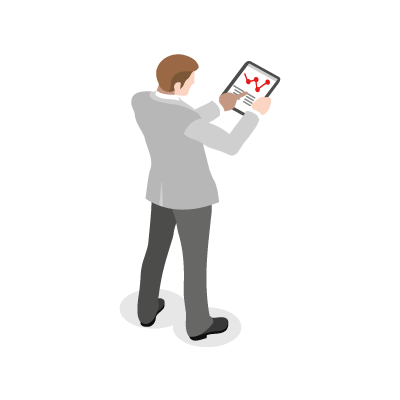Stages of cooperation between UX designer and software house
To answer the above question, it is first necessary to understand what a professional software development process looks like with a breakdown of the various stages. Based on the steps below, I will outline what the role of the UX designer is and where exactly it is in the software implementation process.
The total process of software implementation should consist of the following steps:
1. Meeting with the customer
It is a meeting of a loose form in which the following take part: from the client's side – the person responsible for leading the project, and from the contractor's side – Project Manager, Lead Developer, Lead UX Designer. The purpose of the meeting is to talk about the project, determine the available budget, get to know both parties, and determine the end user of the product.
2. Preparation of project assumptions with a quote
After meeting with the client and gathering information about the project, you should:
– determine the model of cooperation
– select the appropriate technology
– prepare a detailed description of the application with screen sketches based on the customer's description
– determine the duration of the project
3. Start implementation
After acceptance of assumptions and pricing, the project is divided into stages. Then dates are set for meetings with the client to discuss what has been done and the activities in the next stages. Usually the project is divided into so-called. "sprints" of two weeks.
4. UI and UX design, UX mockups
Programmers are not able to make an application without visualizing its screens. Therefore, the design team prepares a "clickable" prototype of the application so that they can plan their work and divide it temporarily into stages.
The design department creates the UI and UX design of the application so that it features:
– intuitiveness
– usability
– visual attractiveness
– simplicity
– simple navigation
– accessibility (the application should be adapted for as many screen variants, resolutions and orientations as possible)
– positive user experience
These are the most important features of a well-designed app and none of them should be neglected. To ensure that the application has all these features UX designers will conduct usability tests with the help of users. Based on the test results obtained, they create the final UI design of the application with interactive (clickable) mockups. They also prepare all the necessary graphics for developers.
5. Implementation of the project from the code side
Once the UX and UI work is completed, the developers move on to the stage of writing the application according to the guidelines received from the UX designers.
6. Tests
Checking all features, screens whether they work as designed on every possible available device on which the app will run. If errors are caught – there is a process of correction and optimization.
7. Deployment to "production"
Making the app accessible to users:
– mobile applications: stores Google Play (Android) and Apple AppStore (iOS) – websites: client's http server
Support, optimization of the various elements of the application, new features.


